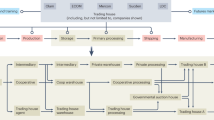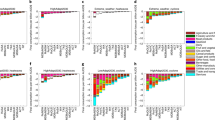Abstract
The agricultural and food systems of the United States are critical for ensuring the stability of both domestic and global food systems. Thus, it is essential to understand the structural resilience of the country’s agri-food supply chains to a suite of threats. Here we employ complex network statistics to identify the spatially resolved structural chokepoints in the agri-food supply chains of the United States. We identify seven chokepoints at county scale: Riverside CA, San Bernardino CA, Los Angeles CA, Shelby TN, Maricopa AZ, San Diego CA and Cook IL; as well as seven chokepoints at freight analysis framework scale: Los Angeles–Long Beach CA, Chicago–Naperville IL, New York–New Jersey NJ, New York–New Jersey NY, Remainder of Texas, Remainder of Pennsylvania, and San Jose–San Francisco–Oakland CA. These structural chokepoints are generally consistent through time (2007, 2012, 2017), particularly for processed food commodities. This study improves our understanding of agri-food supply-chain security and may aid policies aimed at enhancing its resilience.
This is a preview of subscription content, access via your institution
Access options
Access Nature and 54 other Nature Portfolio journals
Get Nature+, our best-value online-access subscription
$29.99 / 30 days
cancel any time
Subscribe to this journal
Receive 12 digital issues and online access to articles
$119.00 per year
only $9.92 per issue
Buy this article
- Purchase on Springer Link
- Instant access to full article PDF
Prices may be subject to local taxes which are calculated during checkout






Similar content being viewed by others
Data availability
All data sources are listed in Methods and are freely available online. Freight analysis framework (FAF)-scale food-flow data are collected from https://faf.ornl.gov/faf5/Default.aspx. The county-scale food flows data are collected from https://doi.org/10.13012/B2IDB-9585947_V1.
Code availability
Code for identifying the structural chokepoints of US food-flow networks in this study was developed in RStudio version 4.0.2. All code will be made available upon reasonable request from the corresponding author.
References
Ercsey-Ravasz, M., Toroczkai, Z., Lakner, Z. & Baranyi, J. Complexity of the international agro-food trade network and its impact on food safety. PLoS ONE 7, e37810 (2012).
Brown, M. et al. Climate Change, Global Food Security and the US Food System (USDA, 2015).
Gbegbelegbe, S., Chung, U., Shiferaw, B., Msangi, S. & Tesfaye, K. Quantifying the impact of weather extremes on global food security: a spatial bio-economic approach. Weather Clim. Extremes 4, 96–108 (2014).
Durand-Morat, A., Nalley, L. L. & Thoma, G. The implications of red rice on food security. Glob. Food Secur. 18, 62–75 (2018).
Walton, R., Miller, J. O. & Champagne, L. Simulating maritime chokepoint disruption in the global food supply. In Proc. 2019 Winter Simulation Conference (WSC) 1708–1718 (IEEE, 2019).
Bailey, R. & Wellesley, L. Chokepoints and Vulnerabilities in Global Food Trade (Chatham House, 2017).
Laborde, D., Martin, W., Swinnen, J. & Vos, R. COVID-19 risks to global food security. Science 369, 500–502 (2020).
Manikas, I., Sundarakani, B., Anastasiadis, F. & Ali, B. A framework for food security via resilient agri-food supply chains: the case of UAE. Sustainability 14, 6375 (2022).
Falkendal, T. et al. Grain export restrictions during COVID-19 risk food insecurity in many low-and middle-income countries. Nat. Food 2, 11–14 (2021).
Biden, J. R. National Security Strategy (The White House, 2022); https://www.whitehouse.gov/wp-content/uploads/2022/10/Biden-Harris-Administrations-National-Security-Strategy-10.2022.pdf
Ericksen, P. J. Conceptualizing food systems for global environmental change research. Glob. Environ. Chang. 18, 234–245 (2008).
Xu, M., Allenby, B. R. & Crittenden, J. C. Interconnectedness and resilience of the US economy. Adv. Complex Syst. 14, 649–672 (2011).
Chopra, S. S. & Khanna, V. Interconnectedness and interdependencies of critical infrastructures in the US economy: implications for resilience. Phys. A Stat. Mech. Appl. 436, 865–877 (2015).
Jahn, M. M. et al. in Strategic Latency Unleashed: The Role of Technology in a Revisionist Global Order and The Implications for Special Operations Forces (eds Davis, Z. S. et al.) 148–158 (Lawrence Livermore National Laboratory, 2021).
Biden, J. R. Executive Order on America’s Supply Chains (The White House, 2021); https://www.whitehouse.gov/briefing-room/presidential-actions/2021/02/24/executive-order-on-americas-supply-chains
Food and agriculture sector-specific plan 2015. CISA https://www.cisa.gov/sites/default/files/publications/nipp-ssp-food-ag-2015-508.pdf (2020).
Margolis, J. T., Sullivan, K. M., Mason, S. J. & Magagnotti, M. A multi-objective optimization model for designing resilient supply chain networks. Int. J. Prod. Econ. 204, 174–185 (2018).
de Sá, M. M., de Souza, M. P. L., de Brito, R. P. & Pereira, S. C. F. Supply chain resilience: the whole is not the sum of the parts. Int. J. Oper. Prod. Manag. 40, 92–115 (2019).
Wahdat, A. Z. & Lusk, J. The achilles heel of the US food industries: exposure to labor and upstream industries in the supply chain. Am. J. Agr. Econ. 105, 624–643 (2023).
Li, Z., Zhao, P. & Han, X. Agri-food supply chain network disruption propagation and recovery based on cascading failure. Phys. A Stat. Mech. Appl. 589, 126611 (2022).
Aramyan, L. H., Oude Lansink, A. G. J. M., van der Vorst, J. G. A. J. & van Kooten, O. Performance measurement in agri-food supply chains: a case study. Supply Chain Manag. 12, 304–315 (2007).
Manzini, R. & Accorsi, R. The new conceptual framework for food supply chain assessment. J. Food Eng. 115, 251–263 (2013).
Chenarides, L., Manfredo, M. & Richards, T. J. COVID-19 and food supply chains. Appl. Econ. Perspect. Policy 43, 270–279 (2021).
Mussell, A., Bilyea, T. & Hedley, D. Agri-food Supply Chains and COVID-19: Balancing Resilience and Vulnerability (Agri-Food Economic Systems, 2020).
Thorpe, J. & Fennelly, S. Climate Change Risks and Supply Chain Responsibility: How Should Companies Respond when Extreme Weather Affects Small-Scale Producers in their Supply Chain? (Oxfam, 2012).
Levermann, A. Climate economics: Make supply chains climate-smart. Nat. News 506, 27–29 (2014).
Godde, C. M., Mason-D’Croz, D., Mayberry, D. E., Thornton, P. K. & Herrero, M. Impacts of climate change on the livestock food supply chain; a review of the evidence. Glob. Food Secur. 28, 100488 (2021).
Davis, Z. S., Rager, C. B., Gac, F., Snow, J. & Reiner, P. Strategic Latency Unleashed: The Role of Technology in a Revisionist Global Order and the Implications for Special Operations Forces (Lawrence Livermore National Laboratory, 2021).
Schneider, C. M., Moreira, A. A., Andrade, J. S., Havlin, S. & Herrmann, H. J. Mitigation of malicious attacks on networks. Proc. Natl Acad. Sci. USA 108, 3838–3841 (2011).
Sheffi, Y. The Resilient Enterprise: Overcoming Vulnerability for Competitive Advantage (Zone Books, 2007).
Karakoc, Deniz Berfin & Konar, M. A complex network framework for the efficiency and resilience trade-off in global food trade. Environ. Res. Lett. 16, 105003 (2021).
Wellesley, L., Preston, F., Lehne, J. & Bailey, R. Chokepoints in global food trade: assessing the risk. Res. Transp. Bus. Manag. 25, 15–28 (2017).
Rivera, L., Sheffi, Y. & Welsch, R. Logistics agglomeration in the US. Transp. Res. A Policy Pract. 59, 222–238 (2014).
As COVID-19 Hit Georgia Meatpacking Counties, Officials and Industry Shifted Blame (Facing South, 2020); https://www.facingsouth.org
NASS Census of Agriculture, State Profile: Texas (USDA, 2017); https://www.nass.usda.gov/Publications/AgCensus/2017/Online_Resources/County_Profiles/Texas/cp99048.pdf
Prokopy, L. S. et al. Useful to usable: developing usable climate science for agriculture. Clim. Risk Manag. 15, 1–7 (2017).
Economic Research Service: Feedgrains Sector at a Glance (USDA, 2022); https://www.ers.usda.gov/
NASS Census of Agriculture State Profile: California (USDA, 2017); https://www.nass.usda.gov/Publications/AgCensus/2017/Online_Resources/County_Profiles/California/cp06019.pdf
Iowa Corn. Food Facts (Iowa Corn Growers Association, 2022); https://www.iowacorn.org/education/food-facts
Blog Archives: Broiler Industry Stretches Its Economic Wings in Delaware (USDA, 2017); https://www.usda.gov/media/blog/2015/01/08/broiler-industry-stretches-its-economic-wings-delaware
Wang, J., Karakoc, D. B. & Konar, M. The carbon footprint of cold chain food flows in the United States. Environ. Res. Infrastruct. Sustain 2, 021002 (2022).
Bingham, D. R., Rushforth, R. R., Stevens, B. & Ruddell, B. L. Mapping local food self-sufficiency in the US and the tradeoffs for food system diversity. Appl. Geogr. 143, 102687 (2022).
Inflation Reduction Act of 2022 (Library of Congress, 2022); https://www.congress.gov/bill/117th-congress/house-bill/5376/text
H.R.4346–117th Congress (2021–2022): Chips and Science Act (Library of Congress, 2022); https://www.congress.gov/bill/117th-congress/house-bill/4346
Weber, C. L. & Scott Matthews, H. Food-miles and the relative climate impacts of food choices in the United States. Environ. Sci. Technol. 42, 3508–3513 (2008).
Foong, A., Pradhan, P., Frör, O. & Kropp, J. P. Adjusting agricultural emissions for trade matters for climate change mitigation. Nat. Commun. 13, 3024 (2022).
Robinson, C., Shirazi, A., Liu, M. & Dilkina, B. Network optimization of food flows in the US. In Proc. 2016 IEEE International Conference on Big Data (Big Data) 2190–2198 (IEEE, 2016).
Osat, S., Faqeeh, A. & Radicchi, F. Optimal percolation on multiplex networks. Nat. Commun. 8, 1540 (2017).
Lin, X., Ruess, P. J., Marston, L. & Konar, M. Food flows between counties in the United States. Environ. Res. Lett. 14, 084011 (2019).
Freight Analysis Framework Version 5 (Oak Ridge National Laboratory, 2020); https://faf.ornl.gov/faf5/
Karakoc, D. B., Wang, J. & Konar, M. Food flows between counties in the United States from 2007 to 2017. Environ. Res. Lett. 17, 034035 (2022).
Karakoc, D. B., Barker, K., Zobel, C. W. & Almoghathawi, Y. Social vulnerability and equity perspectives on interdependent infrastructure network component importance. Sustain. Cities Soc. 57, 102072 (2020).
Hu, J., Du, Y., Mo, H., Wei, D. & Deng, Y. A modified weighted TOPSIS to identify influential nodes in complex networks. Phys. A Stat. Mech. Appl. 444, 73–85 (2016).
Cartographic Boundary Shapefiles (United States Census Bureau, 2021); https://www.census.gov/geographies/mapping-files/2016/geo/carto-boundary-file.html
Acknowledgements
This material is based upon work supported by the National Science Foundation grant no. CBET-1844773 (‘CAREER: A National Strategy for a Resilient Food Supply Chain’), DEB-1924309 (‘CNH2-L: Feedbacks between Urban Food Security and Rural Agricultural Systems’), BCS-2032065 (‘RAPID: Spatial Resilience of Food Production, Supply Chains, and Security to COVID-19’) and CBET-2115405 (‘SRS RN: Multiscale RECIPES (Resilient, Equitable, and Circular Innovations with Partnership and Education Synergies) for Sustainable Food Systems’). Any opinions, findings, and conclusions or recommendations expressed in this material are those of the author(s) and do not necessarily reflect the views of the National Science Foundation.
Author information
Authors and Affiliations
Contributions
D.B.K., M.K., M.J.P. and L.R.V. conceptualized the project. D.B.K. and M.K. developed the methodology. D.B.K. curated the data, conducted the formal analysis and investigation, and generated the data visualizations. D.B.K. and M.K. wrote the original draft of the paper. M.J.P. and L.R.V. reviewed and edited the paper. M.K. supervised the project.
Corresponding author
Ethics declarations
Competing interests
The authors declare no competing interests.
Peer review
Peer review information
Nature Food thanks Prajal Pradhan and the other, anonymous, reviewer(s) for their contribution to the peer review of this work.
Additional information
Publisher’s note Springer Nature remains neutral with regard to jurisdictional claims in published maps and institutional affiliations.
Supplementary information
Supplementary Information
Supplementary Methods, Figs. 1–20, Tables 1–19 and References.
Rights and permissions
Springer Nature or its licensor (e.g. a society or other partner) holds exclusive rights to this article under a publishing agreement with the author(s) or other rightsholder(s); author self-archiving of the accepted manuscript version of this article is solely governed by the terms of such publishing agreement and applicable law.
About this article
Cite this article
Karakoc, D.B., Konar, M., Puma, M.J. et al. Structural chokepoints determine the resilience of agri-food supply chains in the United States. Nat Food 4, 607–615 (2023). https://doi.org/10.1038/s43016-023-00793-y
Received:
Accepted:
Published:
Issue Date:
DOI: https://doi.org/10.1038/s43016-023-00793-y
This article is cited by
-
Ethical Perspectives on Food Morality: Challenges, Dilemmas and Constructs
Food Ethics (2024)
-
Logistics hubs hold food supply chains together
Nature Food (2023)



